Beneficial
Carolina dung beetle, Carolina copris
Family: Scarabaeidae Subfamily: Scarabaeinae Genus: Dichotomius Species: Dichotomius carolinus (Linnaeus, 1767)
none available
Total body length 20.0–30.0 mm (0.78–1.18 in). Body shape distinctly round when viewed from above; may be caked with dung. Color dull black. Clypeusclypeus:
part of the head anterior to the frons; the most anterior portion in dorsal view
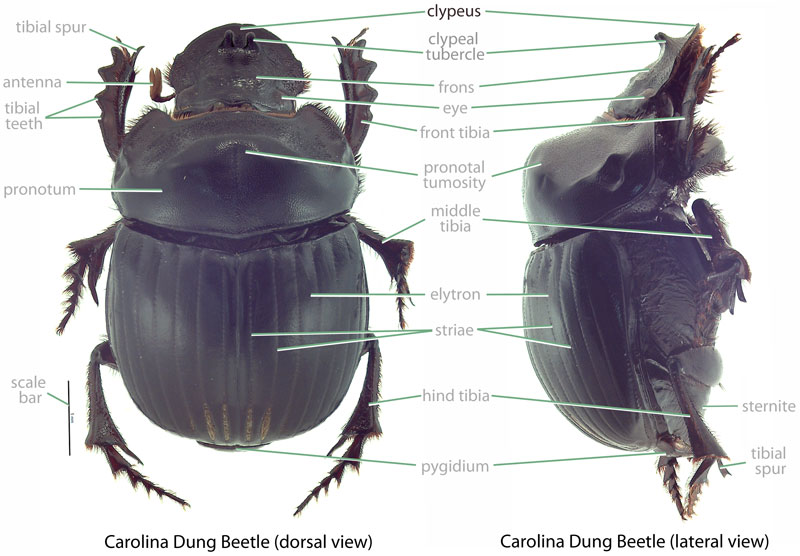 broadly rounded. Head of major male with pairedpaired:
broadly rounded. Head of major male with pairedpaired:
in relation to bilateral symmetry: occurring on both sides of the body
tubercles on clypeusclypeus:
part of the head anterior to the frons; the most anterior portion in dorsal view
 ; clypealclypeal:
; clypealclypeal:
of, or referring to, the clypeus
tubercles reduced in minor male; lacking clypealclypeal:
of, or referring to, the clypeus
tubercles in female. Head of female with single tubercletubercle:
a small, conical knob or horn-like protuberance
on fronsfrons:
part of the head generally positioned between the eyes (posterior to the clypeus and anterior to the vertex) and visible dorsally
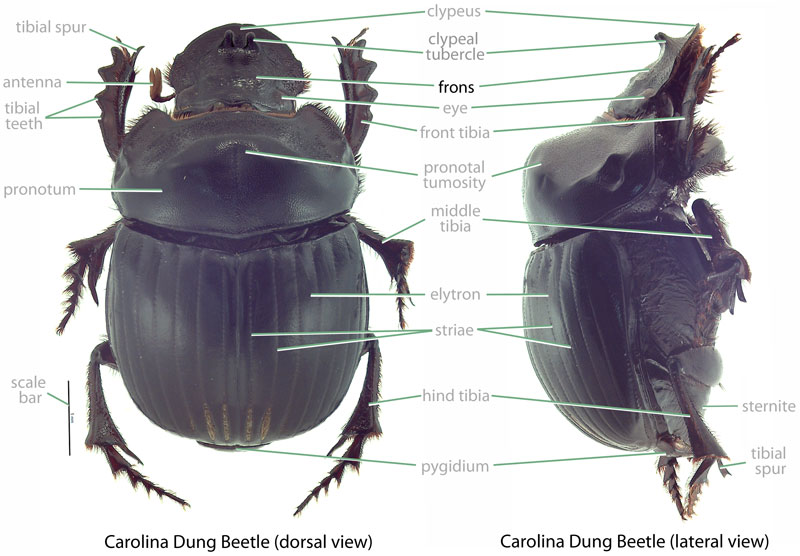 ; tubercletubercle:
; tubercletubercle:
a small, conical knob or horn-like protuberance
on fronsfrons:
part of the head generally positioned between the eyes (posterior to the clypeus and anterior to the vertex) and visible dorsally
 lacking in male. Pronotumpronotum:
lacking in male. Pronotumpronotum:
the dorsal surface of the thorax
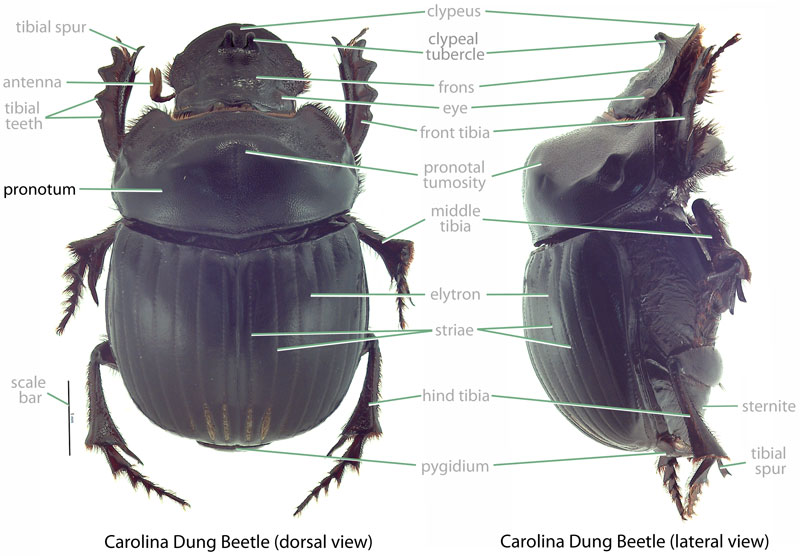 with well-developed tumositytumosity:
with well-developed tumositytumosity:
mound-like protuberance or puffed-up appearance
(male and female); lacking horns. ElytraElytra:
the hardened and chitinous wing-cover of a beetle that protect and overlie the flight wing
with distinct striaestriae:
a longitudinal depressed line or furrow, often formed from numerous punctures that extends the length of an elytron
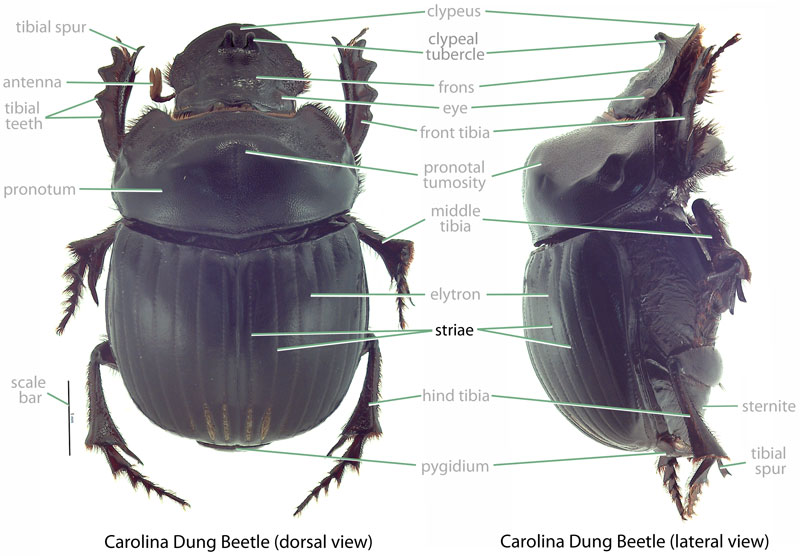 .
.
(Ritcher, 1966Ritcher, 1966:
Ritcher P. 1966. White grubs and their allies: a study of North American scarabaeoid larvae. Oregon State University Monographs, Studies in Entomology 4: 1-219.): Grub C-shaped and hump-backed, cylindrical, cream-colored. Maxillamaxilla:
set of paired mouthparts located posterior to the mandibles
with galeagalea:
outer branch or lobe of the maxilla
 and lacinialacinia:
and lacinialacinia:
inner portion of the maxilla distinctly separate. AntennaeAntennae:
distinctly separate. AntennaeAntennae:
paired sensory organ on head, formed from numerous segments
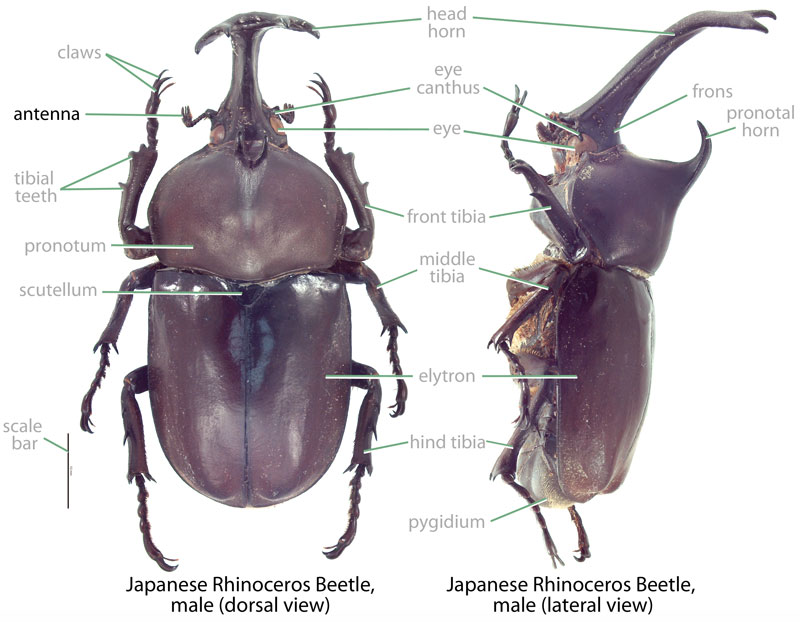 with 4 or 5 apparent segments. Distaldistal:
with 4 or 5 apparent segments. Distaldistal:
situated away from the point of articulation, thus usually furthest from the body
segment of antennaantenna:
paired sensory organ on head, formed from numerous segments
 much reduced in size. Epipharynxepipharynx:
much reduced in size. Epipharynxepipharynx:
lobe on the interior surface of the labrum or clypeus
with tormaetormae:
in scarab larvae, sclerotized structures on the ends of the clypeolateral suture extending towards the mesal line
united mesallymesally:
at or near midline of body
, tormaetormae:
in scarab larvae, sclerotized structures on the ends of the clypeolateral suture extending towards the mesal line
symmetrical; anterioranterior:
the front or forward; opposite of posterior
phoba present. Chaetopariae each consisting of 15–20 setaesetae:
small, hair-like structure
. Prothoracic shieldprothoracic shield:
the chitinous plate behind the head of larvae
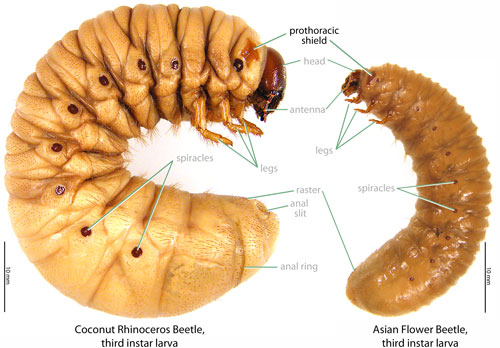 with an anteriorly projecting, angular process on each side. Venter of last abdominal segment with polystichouspolystichous:
with an anteriorly projecting, angular process on each side. Venter of last abdominal segment with polystichouspolystichous:
arranged in multiple rows or series
palidiapalidia:
paired group(s) of recumbent (reclining) spines, usually occurring in rows; part of the raster
. Anal opening surrounded by fleshy lobes. Legs 2-segmented; with pairedpaired:
in relation to bilateral symmetry: occurring on both sides of the body
terminal setae; claws lacking.
Eastern United States. This is a common dung beetle species in many pastures of the eastern U.S., where it is known from southeastern South Dakota southward to eastern Texas and east to southern Florida and New England (Woodruff, 1973Woodruff, 1973:
Woodruff R. 1973. The scarab beetles of Florida (Coleoptera: Scarabaeidae) part I. The Laparosticti (Subfamilies: Scarabaeinae, Aphodiinae, Hybosorinae, Ochodaeinae, Geotrupinae, Acanthocerinae). Arthropods of Florida and Neighboring Land Areas 8: 1-220.).
None. This species feeds on dung as both an adult and larvalarva:
the immature form of an insect; in scarabs, also called grub or white grub; preceded by the egg stage, followed by the pupal stage
 (Woodruff, 1973Woodruff, 1973:
(Woodruff, 1973Woodruff, 1973:
Woodruff R. 1973. The scarab beetles of Florida (Coleoptera: Scarabaeidae) part I. The Laparosticti (Subfamilies: Scarabaeinae, Aphodiinae, Hybosorinae, Ochodaeinae, Geotrupinae, Acanthocerinae). Arthropods of Florida and Neighboring Land Areas 8: 1-220.).
Dichotomius carolinus is a nocturnal species and often is attracted to lights (Woodruff, 1973Woodruff, 1973:
Woodruff R. 1973. The scarab beetles of Florida (Coleoptera: Scarabaeidae) part I. The Laparosticti (Subfamilies: Scarabaeinae, Aphodiinae, Hybosorinae, Ochodaeinae, Geotrupinae, Acanthocerinae). Arthropods of Florida and Neighboring Land Areas 8: 1-220.). Male-female pairs excavate a brood burrow near dung, often leaving a large mound of dirt near the entrance. Such burrows can contain multiple tunnels and are constructed at night near fresh dung in meadows and grasslands. A mass of dung is placed at the end of a tunnel, and an egg is laid within. In Nebraska, adults have been found in June and August (Ratcliffe and Paulsen, 2008Ratcliffe and Paulsen, 2008:
Ratcliffe B and Paulsen P. 2008. The scarabaeoid beetles of Nebraska (Coleoptera: Scarabaeoidea). Bulletin of the University of Nebraska 22: 138-248.). In Florida, however, adults are found throughout the year (Woodruff, 1973Woodruff, 1973:
Woodruff R. 1973. The scarab beetles of Florida (Coleoptera: Scarabaeidae) part I. The Laparosticti (Subfamilies: Scarabaeinae, Aphodiinae, Hybosorinae, Ochodaeinae, Geotrupinae, Acanthocerinae). Arthropods of Florida and Neighboring Land Areas 8: 1-220.).
None. This species recycles dung and is beneficial for ranching and farming in Hawaii. Being a dung feeder, this species poses no threat to crop or ornamental plants. Additionally, this species is not a threat to native dung beetles because none are known from Hawaii or Guam.
Recorded, not established. This species was intentionally released from Florida to the Big Island at Parker Ranch in 1954 (Weber, 1955Weber, 1955:
Weber P. 1955. Recent introductions for biological control in Hawaii—1. Proceedings of the Hawaiian Entomological Society 16: 162-164. full text (accessed 2015)) to help control populations of the horn fly (Haematobia irritans), a biting pest of livestock. Despite this effort Dichotomius carolinus failed to establish populations in the state (Nishida, 2002Nishida, 2002:
Nishida G (editor). 2002. Hawaiian terrestrial arthropod checklist, fourth edition. Bishop Museum Technical Report 22: 1-313.).
Not established or recorded. There are no records of this species from Guam.
In Hawaii, this species was intentionally released but did not establish.
The only dung beetle recorded from Hawaii that reaches the size of Dichotomius carolinus is the similarly colored Catharsius molossus. These species are separated by examining the head (D. carolinus with pairedpaired:
in relation to bilateral symmetry: occurring on both sides of the body
clypealclypeal:
of, or referring to, the clypeus
tubercles in males and females with a tubercletubercle:
a small, conical knob or horn-like protuberance
on the fronsfrons:
part of the head generally positioned between the eyes (posterior to the clypeus and anterior to the vertex) and visible dorsally
 versus C. molossus with a single clypealclypeal:
versus C. molossus with a single clypealclypeal:
of, or referring to, the clypeus
horn in males and females lacking a horn), pronotumpronotum:
the dorsal surface of the thorax
 (D. carolinus always lacking pronotal horns versus C. molossus major males with pronotal horns), and elytraelytra:
(D. carolinus always lacking pronotal horns versus C. molossus major males with pronotal horns), and elytraelytra:
the hardened and chitinous wing-cover of a beetle that protect and overlie the flight wing
(D. carolinus with distinct striaestriae:
a longitudinal depressed line or furrow, often formed from numerous punctures that extends the length of an elytron
 versus C. molossus with indistinct striae).
versus C. molossus with indistinct striae).
Copris carolinus Linnaeus, Copris colonicus Say, Dichotomius colonicus Say, Pinotus bituberculatus Harold, Pinotus carolinus Linnaeus
Report your observation of this beneficial species at our iNaturalist project.